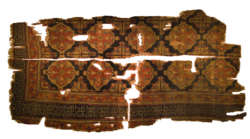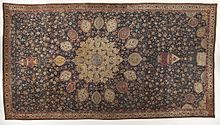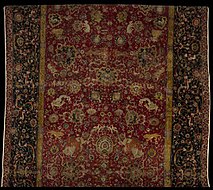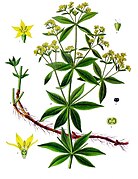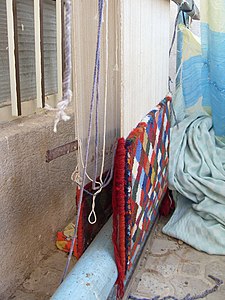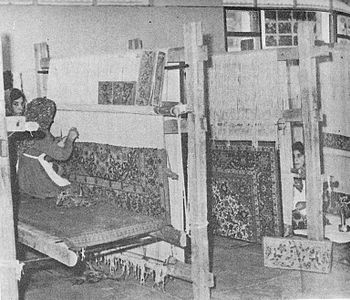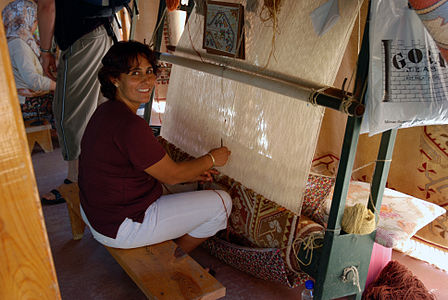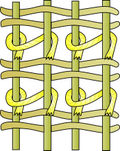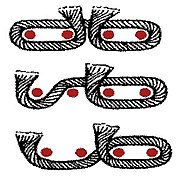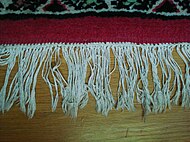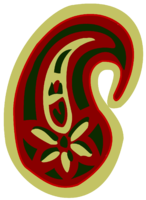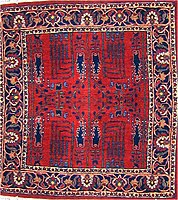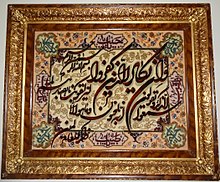Persian carpet




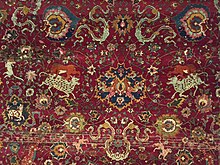
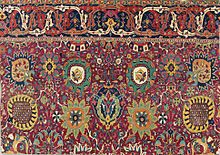
APersian carpet(Persian:فرش ایرانی,romanized:farš-e irâni[ˈfærʃeʔiː.ɹɒː.níː]) orPersian rug(Persian:قالی ایرانی,romanized:qâli-ye irâni[ɢɒːˈliːjeʔiː.ɹɒː.níː]),[1]also known asIranian carpet,is a heavy textile made for a wide variety of utilitarian and symbolic purposes and produced inIran(historically known asPersia), for home use, local sale, and export. Carpet weaving is an essential part ofPersian cultureandIranian art.Within the group ofOriental rugsproduced by the countries of the"rug belt",the Persian carpet stands out by the variety and elaborateness of its manifold designs.
Persian rugs and carpets of various types were woven in parallel by nomadic tribes in village and town workshops, and byroyal courtmanufactories alike. As such, they represent miscellaneous, simultaneous lines of tradition, and reflect thehistory of Iran,Persian culture,and its various peoples. The carpets woven in theSafavidcourt manufactories ofIsfahanduring the sixteenth century are famous for their elaborate colors and artistical design, and are treasured in museums and private collections all over the world today. Their patterns and designs have set an artistic tradition for court manufactories which was kept alive during the entire duration of the Persian Empire up to the last royal dynasty of Iran.
Carpets woven in towns and regional centers likeTabriz,Kerman,Ravar,Neyshabour,Mashhad,Kashan,Isfahan,NainandQomare characterized by their specific weaving techniques and use of high-quality materials, colours and patterns. Town manufactories like those ofTabrizhave played an important historical role in reviving the tradition of carpet weaving after periods of decline. Rugs woven by the villagers and various tribes of Iran are distinguished by their fine wool, bright and elaborate colours, and specific, traditional patterns. Nomadic and small village weavers often produce rugs with bolder and sometimes more coarse designs, which are considered as the most authentic and traditional rugs of Persia, as opposed to the artistic, pre-planned designs of the larger workplaces.Gabbehrugs are the best-known type of carpet from this line of tradition.
As a result of political unrest or commercial pressure, carpet weaving has gone through periods of decline throughout the decades. It particularly suffered from the introduction of synthetic dyes during the second half of the nineteenth century. Carpet weaving still plays a critical role in the economy of modern Iran. Modern production is characterized by the revival of traditional dyeing withnatural dyes,the reintroduction of traditional tribal patterns, but also by the invention of modern and innovative designs, woven in the centuries-old technique. Hand-woven Persian rugs and carpets have been regarded as objects of high artistic and utilitarian value and prestige since the first time they were mentioned byancient Greekwriters.
Although the term "Persian carpet" most often refers to pile-woven textiles, flat-woven carpets and rugs likeKilim,Soumak,and embroidered tissues likeSuzaniare part of the rich and manifold tradition of Persian carpet weaving.
In 2010, the "traditional skills of carpet weaving" inFars ProvinceandKashanwere inscribed to theUNESCO Intangible Cultural Heritage Lists.[2][3]
History[edit]
The beginning of carpet weaving remains unknown, as carpets are subject to use, deterioration, and destruction by insects and rodents. Woven rugs probably developed from earlier floor coverings, made offelt,or a technique known as "flat weaving".[4]Flat-woven rugs are made by tightly interweaving thewarp and weftstrands of the weave to produce a flat surface with no pile. The technique of weaving carpets further developed into a technique known asloop weaving.Loop weaving is done by pulling the weft strings over a gauge rod, creating loops of thread facing the weaver. The rod is then either removed, leaving the loops closed, or the loops are cut over the protecting rod, resulting in a rug very similar to a genuinepile rug.Hand-woven pile rugs are produced by knotting strings of thread individually into the warps, cutting thethreadafter each single knot.
The Pazyryk carpet: Earliest pile-woven carpet[edit]

ThePazyrykcarpet was excavated in 1949 from the grave of aScythiannobleman in the Pazyryk Valley of theAltai MountainsinSiberia.Radiocarbon testing indicated that the Pazyryk carpet was woven in the 5th century BC.[5]This carpet is 183 by 200 centimetres (72 by 79 inches) and has 36 symmetricalknots percm2(232 per inch2).[6]The advanced technique used in the Pazyryk carpet indicates a long history of evolution and experience in weaving. It is considered the oldest known carpet in the world.[7]Its central field is a deep red color and it has two animal frieze borders proceeding in opposite directions accompanied by guard stripes. The inner main border depicts a procession of deer, the outer men on horses, and men leading horses. The horse saddlecloths are woven in different designs. The inner field contains 4 × 6 identical square frames arranged in rows on a red ground, each filled by identical, star-shaped ornaments made up by centrally overlapping x- and cross-shaped patterns. The design of the carpet already shows the basic arrangement of what was to become the standard oriental carpet design: a field with repeating patterns, framed by a main border in elaborate design, and several secondary borders.[citation needed]
The discoverer of the Pazyryk carpet,Sergei Rudenko,assumed it to be a product of the contemporaryAchaemenids.[8][9]Whether it was produced in the region where it was found, or is a product of Achaemenid manufacture, remains subject to debate.[10][11]Its fine weaving and elaborate pictorial design hint at an advanced state of the art of carpet weaving at the time of its production.
Early fragments[edit]
There are documentary records of carpets being used by the ancient Greeks.Homer,assumed to have lived around 850 BC, writes inIliasXVII,350 that the body of Patroklos is covered with a "splendid carpet". InOdysseyBook VII and X "carpets" are mentioned.Pliny the Elderwrote (nat. VIII, 48) that carpets ( "polymita" ) were invented in Alexandria. It is unknown whether these were flatweaves or pile weaves, as no detailed technical information is provided in the Greek and Latin texts.
Flat-wovenkilimsdating to at least the fourth or fifth century AD were found inTurfan,Hotan prefecture,East Turkestan, China, an area which still produces carpets today. Rug fragments were also found in theLop Nurarea, and are woven in symmetrical knots, with 5–7 interwoven wefts after each row of knots, with a striped design, and various colours. They are now in the Victoria and Albert Museum, London.[12]Other fragments woven in symmetrical as well as asymmetrical knots have been found inDura-Europosin Syria,[13]and from the At-Tar caves inIraq,[14]dated to the first centuries AD.
These rare findings demonstrate that all the skills and techniques of dyeing and carpet weaving were already known in western Asia before the first century AD.
Early history: circa 500 BC – 200 AD[edit]
Persian carpets were first mentioned around 400 BC, by the Greek authorXenophonin his book "Anabasis":
"αὖθις δὲ Τιμασίωνι τῷ Δαρδανεῖ προσελθών, ἐπεὶ ἤκουσεν αὐτῷ εἶναι καὶ ἐκπώματα καὶ τάπιδας βαρβαρικάς", (Xen. anab. VII.3.18)
- Next he went to Timasion the Dardanian, for he heard that he had some Persian drinking cups and carpets.
"καὶ Τιμασίων προπίνων ἐδωρήσατο φιάλην τε ἀργυρᾶν καὶ τάπιδα ἀξίαν δέκα μνῶν." [Xen. anab. VII.3.27]
- Timasion also drank his health and presented him with a silver bowl and a carpet worth ten mines.[15]
Xenophon describes Persian carpets as precious, and worthy to be used as diplomatic gifts. It is unknown if these carpets were pile-woven, or produced by another technique, e.g.,flat-weaving,orembroidery,but it is interesting that the very first reference to Persian carpets in the world literature already puts them into a context of luxury, prestige, and diplomacy.
There are no surviving Persian carpets from the reigns of theAchaemenian(553–330 BC),Seleucid(312–129 BC), andParthian(ca. 170 BC – 226 AD) kings.
The Sasanian Empire: 224–651[edit]
TheSasanian Empire,which succeeded theParthian Empire,was recognized as one of the leading powers of its time, alongside its neighbouringByzantine Empire,for a period of more than 400 years.[16]The Sasanids established their empire roughly within the borders set by the Achaemenids, with the capital atCtesiphon.This last Persian dynasty before the arrival ofIslamadoptedZoroastrianismas the state religion.
When and how exactly the Persians started weaving pile carpets is currently unknown, but the knowledge of carpet weaving, and of suitable designs for floor coverings, was certainly available in the area covering Byzance, Anatolia, and Persia:Anatolia,located between Byzance and Persia, was ruled by the Roman Empire since 133 BCE. Geographically and politically, by changing alliances and warfare as well as by trade, Anatolia connected the East Roman with the Persian Empire. Artistically, both empires have developed similar styles and decorative vocabulary, as exemplified by mosaics and architecture of RomanAntioch.[17]A Turkish carpet pattern depicted onJan van Eyck's"Paele Madonna"painting was traced back to late Roman origins and related to early Islamic floor mosaics found in the Umayyad palace ofKhirbat al-Mafjar.[18]
Flat weaving and embroidery were known during the Sasanian period. Elaborate Sasanian silk textiles were well preserved in European churches, where they were used as coverings for relics, and survived in church treasuries.[19]More of these textiles were preserved in Tibetan monasteries, and were removed by monks fleeing to Nepal during theChinese cultural revolution,or excavated from burial sites like Astana, on theSilk RoadnearTurfan.The high artistic level reached by Persian weavers is further exemplified by the report of the historianAl-Tabariabout theSpring of Khosrowcarpet, taken as booty by the Arabian conquerors of Ctesiphon in 637 AD. The description of the rug's design by al-Tabari makes it seem unlikely that the carpet was pile woven.[20][21]
Fragments of pile rugs from findspots in north-easternAfghanistan,reportedly originating from the province ofSamangan,have been carbon-14 dated to a time span from the turn of the second century to the early Sasanian period. Among these fragments, some show depictions of animals, like various stags (sometimes arranged in a procession, recalling the design of the Pazyryk carpet) or a winged mythical creature. Wool is used for warp, weft, and pile, the yarn is crudely spun, and the fragments are woven with the asymmetric knot associated with Persian and far-eastern carpets. Every three to five rows, pieces of unspun wool, strips of cloth and leather are woven in.[22]These fragments are now in theAl-SabahCollection in theDar al-Athar al-Islamiyyah,Kuwait.[23]
The carpet fragments, although reliably dated to the early Sasanian time, do not seem to be related to the splendid court carpets described by the Arab conquerors. Their crude knots incorporatingshagon the reverse hints at the need for increased insulation. With their coarsely finished animal and hunting depictions, these carpets were likely woven by nomadic people.[24]
The advent of Islam and the Caliphates: 651–1258[edit]
TheMuslim conquest of Persialed to the end of the Sasanian Empire in 651 and the eventual decline of the Zoroastrian religion in Persia. Persia became a part of the Islamic world, ruled by MuslimCaliphates.
Arabian geographers and historians visiting Persia provide, for the first time, references to the use of carpets on the floor. The unknown author of theHudud al-'Alamstates that rugs were woven in Fārs. 100 years later,Al-Muqaddasirefers to carpets in the Qaināt.Yaqut al-Hamawitells us that carpets were woven inAzerbaijānin the thirteenth century. The great Arabian travellerIbn Battutamentions that a green rug was spread before him when he visited the winter quarter of the BakhthiariatabeginIdhej.These references indicate that carpet weaving in Persia under the Caliphate was a tribal or rural industry.[25]
The rule of the Caliphs over Persia ended when theAbbasid Caliphatewas overthrown in theSiege of Baghdad (1258)by theMongol EmpireunderHulagu Khan.The Abbasid line of rulers recentered themselves in theMamlukcapital ofCairoin 1261. Though lacking in political power, the dynasty continued to claim authority in religious matters until after theOttomanconquest of Egypt(1517). Under the Mamluk dynasty in Cairo, large carpets known as "Mamluk carpets" were produced.[26]
Seljuq invasion and Turko-Persian tradition: 1040–1118[edit]
Beginning at latest with theSeljuqinvasions of Anatolia and northwestern Persia, a distinctTurko-Persian traditionemerged. Fragments of woven carpets were found in theAlâeddin Mosquein the Turkish town ofKonyaand theEşrefoğlu MosqueinBeyşehir,and were dated to the Anatolian Seljuq Period (1243–1302).[27][28]More fragments were found inFostat,today a suburb of the city of Cairo.[29]These fragments at least give us an idea how Seluq carpets may have looked. The Egyptian findings also provide evidence for export trade. If, and how, these carpets influenced Persian carpet weaving, remains unknown, as no distinct Persian carpets are known to exist from this period, or we are unable to identify them. It was assumed by Western scholars that the Sejuqs may have introduced at least new design traditions, if not the craft of pile weaving itself, to Persia, where skilled artisans and craftsmen might have integrated new ideas into their old traditions.[20]
-
Carpet fragment fromEşrefoğlu Mosque,Beysehir,Turkey. Seljuq Period, 13th century.
-
Seljuq carpet, 320 by 240 centimetres (126 by 94 inches), from theAlâeddin Mosque,Konya,13th century
The Mongol Ilkhanate (1256–1335) and Timurid Empire (1370–1507)[edit]
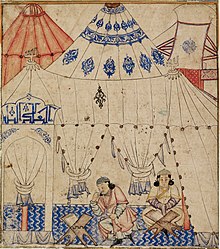
Between 1219 and 1221, Persia was raided by theMongols.After 1260, the title"Ilkhan"was borne by the descendants ofHulagu Khanand later other Borjigin princes in Persia. At the end of the thirteenth century,GhazanKhan built a new capital at Shãm, near Tabriz. He ordered the floors of his residence to be covered with carpets from Fārs.[25]
With the death of Ilkhan Abu Said Bahatur in 1335, Mongol rule faltered and Persia fell into political anarchy. In 1381,Timurinvaded Iran and became the founder of theTimurid Empire.His successors, the Timurids, maintained a hold on most of Iran until they had to submit to the"White Sheep" Turkmenconfederation underUzun Hassanin 1468; Uzun Hasan and his successors were the masters of Iran until the rise of the Safavids.
In 1463, the Venetian Senate, seeking allies in theOttoman–Venetian War (1463–1479)established diplomatic relations with Uzun Hassans court at Tabriz. In 1473,Giosafat Barbarowas sent to Tabriz. In his reports to the Senate of Venetia he mentions more than once the splendid carpets which he saw at the palace. Some of them, he wrote, were of silk.[30]
In 1403–05Ruy González de Clavijowas the ambassador ofHenry III of Castileto the court ofTimur,founder and ruler of theTimurid Empire.He described that in Timur's palace atSamarkand,"everywhere the floor was covered with carpets and reed mattings".[31]Timurid period miniatures show carpets with geometrical designs, rows of octagons and stars, knot forms, and borders sometimes derived fromkuficscript. None of the carpets woven before 1500 AD have survived.[25]
The Safavid Period (1501–1732)[edit]


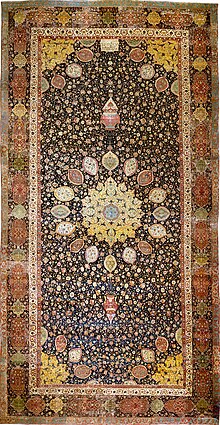
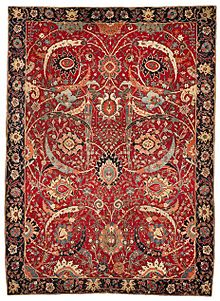
In 1499, a new dynasty arose in Persia. ShahIsmail I,its founder, was related to Uzun Hassan. He is regarded as the first national sovereign of Persia since the Arab conquest, and establishedShi'a Islamas the state religion of Persia.[32]He and his successors, ShahTahmasp Iand ShahAbbas Ibecame patrons of the PersianSafavid art.Court manufactories were probably established by Shah Tahmasp in Tabriz, but definitely by Shah Abbas when he moved his capital from Tabriz in northwestern toIsfahanin central Persia, in the wake of theOttoman–Safavid War (1603–18).For the art of carpet weaving in Persia, this meant, as Edwards wrote: "that in a short time it rose from a cottagemétierto the dignity of a fine art. "[25]
The time of theSafavid dynastymarks one of the greatest periods inPersian art,which includes carpet weaving. Later Safavid period carpets still exist, which belong to the finest and most elaborate weavings known today. The phenomenon that the first carpets physically known to us show such accomplished designs leads to the assumption that the art and craft of carpet weaving must already have existed for some time before the magnificent Safavid court carpets could have been woven. As no early Safavid period carpets survived, research has focused on Timurid period book illuminations andminiaturepaintings. These paintings depict colourful carpets with repeating designs of equal-scale geometric patterns, arranged in checkerboard-like designs, with "kufic" border ornaments derived fromIslamic calligraphy.The designs are so similar to period Anatolian carpets, especially to "Holbein carpets"that a common source of the design cannot be excluded: Timurid designs may have survived in both the Persian and Anatolian carpets from the early Safavid, and Ottoman period.[33]
The "design revolution"[edit]
By the late fifteenth century, the design of the carpets depicted in miniatures changed considerably. Large-format medaillons appeared, ornaments began to show elaborate curvilinear designs. Large spirals and tendrils, floral ornaments, depictions of flowers and animals, were often mirrored along the long or short axis of the carpet to obtain harmony and rhythm. The earlier "kufic" border design was replaced by tendrils andarabesques.All these patterns required a more elaborate system of weaving, as compared to weaving straight, rectilinear lines. Likewise, they require artists to create the design, weavers to execute them on the loom, and an efficient way to communicate the artist's ideas to the weaver. Today this is achieved by a template, termed cartoon (Ford, 1981, p. 170[34]). How Safavid manufacturers achieved this, technically, is currently unknown. The result of their work, however, was whatKurt Erdmanntermed the"carpet design revolution".[35]
Apparently, the new designs were developed first by miniature painters, as they started to appear in book illuminations and on book covers as early as in the fifteenth century. This marks the first time when the "classical" design of Islamic rugs was established: The medaillon and corner design (pers.: "Lechek Torūnj" ) was first seen on book covers. In 1522, Ismail I employed the miniature painterKamāl ud-Dīn Behzād,a famous painter of the Herat school, as director of the royal atelier. Behzad had a decisive impact on the development of later Safavid art. The Safavid carpets known to us differ from the carpets as depicted in the miniature paintings, so the paintings cannot support any efforts to differentiate, classify and date period carpets. The same holds true for European paintings: Unlike Anatolian carpets, Persian carpets were not depicted in European paintings before the seventeenth century.[36]As some carpets like theArdabil carpetshave inwoven inscriptions including dates, scientific efforts to categorize and date Safavid rugs start from them:
I have no refuge in the world other than thy threshold.
There is no protection for my head other than this door.
The work of the slave of the threshold Maqsud of Kashan in the year 946.— Inwoven inscription of the Ardabil carpet
The AH year of 946 corresponds to AD 1539–1540, which dates the Ardabil carpet to the reign of Shah Tahmasp, who donated the carpet to the shrine of ShaykhSafi-ad-din ArdabiliinArdabil,who is regarded as the spiritual father of the Safavid dynasty.
Another inscription can be seen on the "Hunting Carpet", now at theMuseo Poldi Pezzoli,Milan, which dates the carpet to 949 AH/AD 1542–3:
By the diligence of Ghyath ud-Din Jami was completed
This renowned work, that appeals to us by its beauty
In the year 949— Inwoven inscription of the Milan Hunting carpet
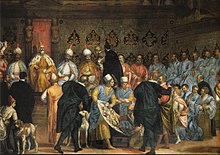
The number of sources for more precise dating and the attribution of provenience increase during the 17th century. Safavid carpets were presented as diplomatic gifts to European cities and states, as diplomatic relations intensified. In 1603, Shah Abbas presented a carpet with inwoven gold and silver threads to the Venetian dogeMarino Grimani.European noblemen began ordering carpets directly from the manufactures of Isfahan and Kashan, whose weavers were willing to weave specific designs, like European coats of arms, into the commissioned pieces. Their acquisition was sometimes meticulously documented: In 1601, the Armenian Sefer Muratowicz was sent to Kashan by the Polish kingSigismund III Vasato commission 8 carpets with the Polish royal court of arms to be inwoven. The Kashan weavers did so, and on 12 September 1602 Muratowicz presented the carpets to the Polish king, and the bill to the treasurer of the crown.[36]Representative Safavid carpets made of silk with inwoven gold and silver threads were erroneously believed by Western art historians to be of Polish manufacture. Although the error was corrected, carpets of this type retained the name of "Polish" or "Polonaise" carpets. The more appropriate type name of "Shah Abbas" carpets was suggested byKurt Erdmann.[36]
Masterpieces of Safavid carpet weaving[edit]
A. C. Edwards opens his book on Persian carpets with the description of eight masterpieces from this great period:
- Ardabil Carpet –Victoria and Albert Museum
- Hunting Carpet – AustrianMuseum of Applied Arts, Vienna
- Chelsea Carpet –Victoria and Albert Museum
- Allover Animal and Floral Carpet – AustrianMuseum of Applied Arts, Vienna
- Rose-ground Vase Carpet –Victoria and Albert Museum
- Medaillion Animal and Floral Carpet with Inscription Guard –Museo Poldi Pezzoli,Milan
- Inscribed Medaillon Carpet with Animal and Flowers and Inscription Border –Metropolitan Museum of Art,Accession Number: 32.16
- Medaillon, Animal, and Tree Carpet –Musée des Arts Décoratifs, Paris
Safavid "Vase technique" carpets from Kirmān[edit]
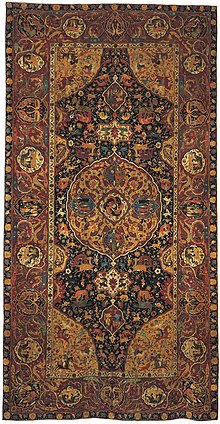

A distinct group of Safavid carpets can be attributed to the region of Kirmān in southern Persia. May H. Beattie identified these carpets by their common structure:[37]Seven different types of carpets were identified: Garden carpets (depicting formal gardens and water channels); carpets with centralized designs, characterized by a large medallion; multiple-medaillon designs with offset medaillons and compartment repeats; directional designs with the arrangements of little scenes used as individual motifs; sickle-leaf designs where long, curved, serrated and sometimes compound leaves dominate the field; arabesque; and lattice designs. Their distinctive structure consists of asymmetric knots; the cotton warps are depressed, and there are three wefts. Woolen wefts lie hidden in the center of the carpet, making up the first and third weft. Silk or cotton makes up the middle weft, which crosses from back to front. A characteristic "tram line" effect is evoked by the third weft when the carpet is worn.
The best known "vase technique" carpets from Kirmān are those of the so-called "Sanguszko group", named after theHouse of Sanguszko,whose collection has the most outstanding example. The medallion-and-corner design is similar to other 16th century Safavid carpets, but the colours and style of drawing are distinct. In the central medallion, pairs of human figures in smaller medallions surround a central animal combat scene. Other animal combats are depicted in the field, while horsemen are shown in the corner medallions. The main border also contains lobed medallions withHouris,animal combats, or confronting peacocks. In-between the border medallions, phoenixes and dragons are fighting. By similarity to mosaic tile spandrels in theGanjali Khan Complexat the Kirmān bazaar with an inscription recording its date of completion as 1006 AH/AD 1596, they are dated to the end of the 16th or the beginning of the 17th century.[38]Two other "vase technique" carpets have inscriptions with a date: One of them bears the date 1172 AH/AD 1758 and the name of the weaver: the Master Craftsman Muhammad Sharīf Kirmānī, the other has three inscriptions indicating that it was woven by the Master Craftsman Mu'min, son of Qutb al-Dīn Māhānī, between 1066–7 AH/AD 1655–1656. Carpets in the Safavid tradition were still woven in Kirmān after the fall of the Safavid dynasty in 1732 (Ferrier, 1989, p. 127[38]).
The end ofShah Abbas II's reign in 1666 marked the beginning of the end of the Safavid dynasty. The declining country was repeatedly raided on its frontiers. Finally, aGhilzaiPashtunchieftain namedMir Wais Khanbegan a rebellion inKandaharand defeated the Safavid army under the Iranian Georgian governor over the region,Gurgin Khan.In 1722,Peter the Greatlaunched theRusso-Persian War (1722–1723),capturing many of Iran's Caucasian territories, includingDerbent,Shaki,Baku,but alsoGilan,MazandaranandAstrabad.In 1722, an Afghan army led byMir Mahmud Hotakimarched across eastern Iran, andbesieged and took Isfahan.Mahmud proclaimed himself 'Shah' of Persia. Meanwhile, Persia's imperial rivals, the Ottomans and the Russians, took advantage of the chaos in the country to seize more territory for themselves.[39]With these events, the Safavid dynasty had come to an end.
Gallery: Persian carpets from the Safavid Era[edit]
-
Zayn al-'Abidin bin ar-Rahman al-Jami – Early 16th century miniature,Walters Art Museum
-
Ardabil Carpet at theLACMA
-
The Emperor's Carpet (detail), second half of the 16th century, Iran.Metropolitan Museum of Art,New York
-
"Vase technique" carpet, Kirmān, 17th century
-
Safavid Persian carpet "Mantes carpet"atThe Louvre
-
Detail of a Persian Animal carpet, Safavid period, Persia, 16th century,Museum für Kunst und Gewerbe Hamburg
-
Detail of a Persian Animal carpet, Safavid period, Persia, 16th century: Lion andQilin,Museum für Kunst und Gewerbe Hamburg
The Afsharid (1736–1796) and Zand (1750–1796) dynasties[edit]

Iran's territorial integrity was restored by a native IranianTurkicAfsharwarlord from Khorasan,Nader Shah.He defeated the Afghans, andOttomans,reinstalledthe Safavids on the throne, and negotiated Russian withdrawal from Irans Caucasian territories, by theTreaty of ReshtandTreaty of Ganja.By 1736, Nader himself was crowned shah. There are no records of carpet weaving, which had sunk to an insignificant handicraft, during theAfsharidandZanddynasties.[25]
The Qajãr dynasty (1789–1925)[edit]
In 1789,Mohammad Khan Qajarwas crowned king of Persia, the founder of theQajar dynasty,which provided Persia with a long period of order and comparative peace, and the industry had an opportunity of revival. The three important Qajãr monarchsFath-Ali Shah Qajar,Naser al-Din Shah Qajar,andMozaffar ad-Din Shah Qajarrevived the ancient traditions of the Persian monarchy. The weavers of Tabriz took the opportunity, and around 1885 became the founders of the modern industry of carpet weaving in Persia.[25]
The Pahlavi dynasty (1925–1979)[edit]
In the aftermath of theRussian Revolution,Persia had become a battleground. In 1917, Britain used Iran as the springboard for an attack into Russia in anunsuccessful attemptto reverse the Revolution. TheSoviet Unionresponded by anne xing portions of northern Persia, creating thePersian Soviet Socialist Republic.By 1920, the Iranian government had lost virtually all power outside its capital: British and Soviet forces exercised control over most of the Iranian mainland.
In 1925 Rezā Shāh, supported by the British government, deposedAhmad Shah Qajar,the lastShahof theQajar dynasty,and founded thePahlavi dynasty.He established a constitutional monarchy that lasted until theIranian Revolutionin 1979. Reza Shah introduced social, economic, and political reforms, ultimately laying the foundation of the modern Iranian state. To stabilize and legitimate their reign, Rezā Shāh and his sonMohammad Reza Pahlaviaimed at reviving ancient Persian traditions. The revival of carpet weaving, often referring to traditional designs, was an important part of these efforts. In 1935, Rezā Shāh founded the Iran Carpet Company, and brought carpet weaving under government control. Elaborate carpets were woven for export, and as diplomatic gifts to other states.[40]
The Pahlavi dynasty modernized and centralized the Iranian government, and sought effective control and authority over all their subjects. Reza Shah was the first Persian monarch to confront this challenge with modern weapons. Enforced by the army, nomadism was outlawed during the 1930s, traditional tribal dresses were banned, the use of tents and yurts was forbidden in Iran. Unable to migrate, having lost their herds, many nomadic families starved to death. A brief era of relative peace followed for the nomadic tribes in the 1940s and 1950s, when Persia was involved in the Second World War, and Rezā Shāh was forced to abdicate in 1941. His successor, Mohammed Reza Shah consolidated his power during the 1950s. His land reform program of 1962, part of the so-calledWhite Revolution,despite obvious advantages for landless peasants, destroyed the traditional political organization of nomadic tribes like theQashqai people,and the traditional way of nomadic life. The centuries-old traditions of nomadic carpet weaving, which had entered a process of decline with the introduction of synthetic dyes and commercial designs in the late nineteenth century, were almost annihilated by the politics of the last Iranian imperial dynasty.[41]
-
Carpet in theNiavaran Palace,Tehran
-
Carpet in theNiavaran Palace,Tehran
Modern times[edit]
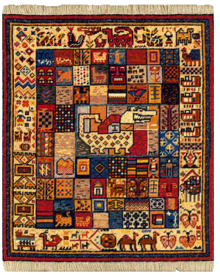
After theIranian Revolution,little information could at first be obtained about carpet weaving in Iran. In the 1970s and 1980s, a new interest arose in Europe inGabbehrugs, which were initially woven by nomadic tribes for their own use. Their coarse weaving and simple, abstract designs appealed to Western customers.
In 1992, the first Grand Persian Conference and Exhibition in Tehran presented for the first time modern Persian carpet designs.[42]Persian master weavers like Razam Arabzadeh displayed carpets woven in the traditional technique, but with unusual, modern designs.[43]As the Grand Conferences continue to take place at regular intervals, two trends can be observed in Iranian carpet weaving today. On the one hand, modern and innovative artistic designs are invented and developed by Iranian manufacturers, who thus take the ancient design tradition forward towards the twenty-first century. On the other hand, the renewed interest in natural dyes[44]was taken up by commercial enterprises, which commission carpets to tribal village weavers. This provides a regular source of income for the carpet weavers. The companies usually provide the material and specify the designs, but the weavers are allowed some degree of creative freedom. With the end of the U.S.embargoon Iranian goods, also Persian carpets (including antique Persian carpets acquired at auctions) may become more easily available to U.S. customers again.
As commercial household goods, Persian carpets today are encountering competition from other countries with lower wages and cheaper methods of production: Machine-woven,tuftedrugs, or rugs woven by hand, but with the faster and less costly loop weaving method, provide rugs in "oriental" designs of utilitarian, but no artistic value. Traditional hand woven carpets, made of sheep wool dyed with natural colours are increasingly sought after. They are usually sold at higher prices due to the large amount of manual work associated with their production, which has, essentially, not changed since ancient times, and due to the artistic value of their design. Thus, the Persian carpet retains its ancient status as an object of luxury, beauty, and art.
Materials[edit]
Wool[edit]
In most Persian rugs, the pile is ofsheep's wool. Its characteristics and quality vary from each area to the next, depending on the breed of sheep, climatic conditions, pasturage, and the particular customs relating to when and how the wool is shorn and processed.[45]Different areas of a sheep's fleece yield different qualities of wool, depending on the ratio between the thicker and stiffer sheep hair and the finer fibers of the wool. Usually, sheep areshornin spring and fall. The spring shear produces wool of finer quality. The lowest grade of wool used in carpet weaving is "skin" wool, which is removed chemically from dead animal skin.[25]Higher grades of Persian wool are often referred to askurk,orkorkwool, which is gained from the wool growing on the sheep's neck.[45]Modern production also makes use of imported wool, e.g.Merinowool from New Zealand, because the high demand on carpet wool cannot be entirely met by the local production. Fibers from camels and goats are also used. Goat hair is mainly used for fastening the borders, or selvedges, of nomadic rugs likebalochi rugs,since it is more resistant to abrasion. Camel wool is occasionally used in Persian nomadic rugs. It is often dyed in black, or used in its natural colour. More often, wool said to be camel's wool turns out to be dyed sheep wool.[25]
Cotton[edit]
Cotton forms the foundation of warps and wefts of the majority of modern rugs. Nomads who cannot afford to buy cotton on the market use wool for warps and wefts, which are also traditionally made of wool in areas where cotton was not a local product. Cotton can be spun more tightly than wool, and tolerates more tension, which makes cotton a superior material for the foundation of a rug. Especially larger carpets are more likely to lie flat on the floor, whereas wool tends to shrink unevenly, and carpets with a woolen foundation may buckle when wet.[45]Chemically treated (mercerised) cotton has been used in rugs as a silk substitute since the late nineteenth century.[45]
Silk[edit]
Silk is an expensive material, and has been used for representative carpets. Its tensile strength has been used in silk warps, but silk also appears in the carpet pile. Silk pile can be used to highlight special elements of the design. High-quality carpets from Kashan, Qum, Nain, and Isfahan have all-silk piles. Silk pile carpets are often exceptionally fine, with a short pile and an elaborate design. Silk pile is less resistant to mechanical stress, thus, all-silk piles are often used aswall hangings,or pillows.
Spinning[edit]

The fibers of wool, cotton, and silk are spun either by hand or mechanically by usingspinning wheelsor industrialspinning machinesto produce the yarn. The direction in which the yarn is spun is calledtwist.Yarns are characterized as S-twist or Z-twist according to the direction of spinning (see diagram).[46]Two or more spun yarns may be twisted together orpliedto form a thicker yarn. Generally, handspun single plies are spun with a Z-twist, and plying is done with an S-twist. Like nearly all Islamic rugs with the exception of Mamluk carpets, nearly all Persian rugs use "Z" (anti-clockwise) spun and "S" (clockwise)-plied wool.
Dyeing[edit]

The dyeing process involves the preparation of the yarn to make it susceptible for the proper dyes by immersion in amordant.Dyestuffs are then added to the yarn which remains in the dyeing solution for a defined time. The dyed yarn is then left to dry, exposed to air and sunlight. Some colours, especially dark brown, require iron mordants, which can damage or fade the fabric. This often results in faster pile wear in areas dyed in dark brown colours, and may create a relief effect in antique oriental carpets.
Plants[edit]
Traditional dyesused in Persian rugs are obtained from plants and insects. In 1856, the English chemistWilliam Henry Perkininvented the firstanilinedye,mauveine.A variety of other syntheticdyeswere invented thereafter. Cheap, readily prepared and easy to use as they were compared to natural dyes, their use is documented since the mid 1860s. The tradition of natural dyeing was revived in Turkey in the early 1980s. Chemical analyses led to the identification of natural dyes from antique wool samples, and dyeing recipes and processes were experimentally re-created.[47][48]
According to these analyses, natural dyes used for carpet wool include:
- RedfromMadder (Rubia tinctorum)roots,
- Yellowfrom plants, includingonion (Allium cepa),several chamomile species (Anthemis,Matricaria chamomilla), andEuphorbia,
- Black:Oak apples,Oak acorns,Tanner's sumach,
- Greenby double dyeing withIndigoand yellow dye,
- Orangeby double dyeing with madder red and yellow dye,
- Blue:Indigo gained fromIndigofera tinctoria.
Some of the dyestuffs like indigo or madder were goods of trade, and thus commonly available. Yellow or brown dyestuffs more substantially vary from region to region. Many plants provide yellow dyes, like Vine weld, or Dyer's weed(Reseda luteola),Yellow larkspur, or Dyer's sumachCotinus coggygria.Grape leaves and pomegranate rinds, as well as other plants, provide different shades of yellow.[45]
In Iran, traditional dyeing with natural dyes was revived in the 1990s, inspired by the renewed general interest in traditionally produced rugs, but master dyers like Abbas Sayahi had kept alive the knowledge about the traditional recipes.[44]
Insect reds[edit]
Carminedyes are obtained from resinous secretions of scale insects such as theCochinealscaleCoccus cacti,and certain Porphyrophora species (ArmenianandPolish cochineal). Cochineal dye, the so-called "laq" was formerly exported from India, and later on from Mexico and the Canary Islands. Insect dyes were more frequently used in areas whereMadder (Rubia tinctorum)was not grown, like west and north-west Persia.[25]
Synthetic dyes[edit]
With modern syntheticdyes,nearly every colour and shade can be obtained so that without chemical analysis it is nearly impossible to identify, in a finished carpet, whether natural or artificial dyes were used. Modern carpets can be woven with carefully selected synthetic colours, and provide artistic and utilitarian value.[49]
Abrash[edit]
The appearance of slight deviations within the same colour is called abrash (from Turkishabraş,literally, "speckled, piebald" ). Abrash is seen in traditionally dyed oriental rugs. Its occurrence suggests that a single weaver has likely woven the carpet, who did not have enough time or resources to prepare a sufficient quantity of dyed yarn to complete the rug. Only small batches of wool were dyed from time to time. When one string of wool was used up, the weaver continued with the newly dyed batch. Because the exact hue of colour is rarely met again when a new batch is dyed, the colour of the pile changes when a new row of knots is woven in. As such, the colour variation suggests a village or tribal woven rug, and is appreciated as a sign of quality and authenticity. Abrash can also be introduced on purpose into a newly planned carpet design.[50]
-
Indigo, historical dye collection of theDresden University of Technology,Germany
-
Kermez (Coccus cacti) lice
-
Section (central medallion) of a South Persian rug, probably Qashqai, late 19th century, showing irregular blue colours (abrash)
Techniques and structures[edit]
The process of weaving a rug[edit]

The weaving of pile rugs is a time-consuming process which, depending on the quality and size of the rug, may take anywhere from a few months to several years to complete.
To begin making a rug, one needs a foundation consisting of warps and wefts:Warpsare strong, thick threads of cotton, wool or silk which run through the length of the rug. Similar threads which pass under and over the warps from one side to the other are calledwefts.The warps on either side of the rug are normally plied into one or more strings of varying thickness that are overcast to form the selvedge.
Weaving normally begins from the bottom of the loom, by passing a number of wefts through the warps to form a base to start from. Knots of dyed wool, cotton or silk threads are then tied in rows around consecutive sets of adjacent warps. As more rows are tied to the foundation, these knots become the pile of the rug. Between each row of knots, one or more shots of weft are passed to keep the knots fixed. The wefts are then beaten down by a comb-like instrument, the comb beater, to further compact and secure the newly woven row. Depending on the fineness of the weave, the quality of the materials and the expertise of the weavers, theknot countof a handmade rug can vary anywhere from 16 to 800 knots per square inch.
When the rug is completed, the warp ends form the fringes that may be weft-faced, braided, tasseled, or secured in other ways.
Looms[edit]
Looms, while sharing fundamental design principles, exhibit a diverse range of sizes and levels of complexity. The core technical requirements of a loom are to maintain proper tension and to divide the warp threads into alternating sets or "leaves." The inclusion of ashedding deviceenables the weaver to efficiently pass the weft threads through the crossed and uncrossed warp threads, eliminating the need for the painstaking process of manually weaving the weft in and out of the warp.
Horizontal looms[edit]

The simplest form of loom is a horizontal; one that can be staked to the ground or supported by sidepieces on the ground. The necessary tension can be obtained through the use of wedges. This style of loom is ideal for nomadic people as it can be assembled or dismantled and is easily transportable. Rugs produced on horizontal looms are generally fairly small and the weave quality is inferior to those rugs made on a professional standing loom.[25]Urbanites are unlikely to use horizontal looms as they take up a lot of floor space, and professionals are unlikely to use them as they are unergonomic. Their cheapness and portability is less valuable to urban professionals.[51]
Vertical looms[edit]
Right, a traditional loom used by a very young villager
in the Iranian desert in 1999. Note weaver's platform.
The technically more advanced, stationary vertical looms are used in villages and town manufactures. The more advanced types of vertical looms are more comfortable, as they allow for the weavers to retain their position throughout the entire weaving process. The Tabriz type of vertical loom allows for weaving of carpets up to double the length of the loom, while there is no limit to the length of the carpet that can be woven on a vertical roller beam loom. In essence, the width of the carpet is limited by the length of the loom beams.[25]
There are three general types of vertical looms, all of which can be modified in a number of ways: the fixed village loom, theTabrizor Bunyan loom, and the roller beam loom.
- The fixed village loom (dar sabet[51]) is used mainly inIranand consists of a fixed upper beam and a moveable lower or cloth beam which slots into two sidepieces. The correct tension of the warps is obtained by driving wedges into the slots. The weavers work on an adjustable plank which is raised as the work progresses.
- The Tabriz loom (dar Tabriz[51]), named after the city ofTabriz,is used in Northwestern Iran. The warps are continuous and pass around behind the loom. Warp tension is obtained with wedges. The weavers sit on a fixed seat and when a portion of the carpet has been completed, the tension is released and the carpet is pulled down and rolled around the back of the loom. This process continues until the rug is completed, when the warps are severed and the carpet is taken off the loom.
- The roller beam loom (dar gardan,[51]"roller loom" ) is used in larger Turkish manufactures, but is also found in Persia and India. It consists of two movable beams to which the warps are attached. Both beams are fitted with ratchets or similar locking devices. Once a section of the carpet is completed, is rolled on to the lower beam. On a roller beam loom, any length of carpet can be produced. In some areas of Turkey several rugs are woven in series on the same warps, and separated from each other by cutting the warps after the weaving is finished.

The Iranian names for the parts of the loom are:[52]
- sardar,the upper beam (horizontal, equivalent to the warp beam)
- zirdar,the lower beam (horizontal, equivalent to the breast beam, especially when the fell is wrapped around it )
- rasto,the right post (upright); sometimes used for both posts
- chapro,the right post (upright)
- kajuofkoji
- huforhaf
- goveh,the wedges regulating the height of the zirdar to tension the warp.
- takhteh alvar,weaver's bench, which may be adjustable in height.
A horizontal loom also has four pegs to hold it in the ground.[51]
Tools[edit]

The weaver needs a number of essential tools: a knife for cutting the yarn as the knots are tied; a heavy comb-like instrument with a handle for packing down the wefts; and a pair of shears for trimming the pile after a row of knots, or a small number of rows, have been woven. In Tabriz the knife is combined with a hook to tie the knots, which speeds up work. A small steel comb is sometimes used to comb out the yarn after each row of knots is completed.
A variety of additional instruments are used for packing the weft. Some weaving areas in Iran known for producing very fine pieces use additional tools. InKerman,a saber like instrument is used horizontally inside the shed. InBijar,a nail-like tool is inserted between the warps, and beaten on to compact the fabric even more. Bijar is also famous for their wet loom technique, which consists of wetting the warp, weft, and yarn with water throughout the weaving process to compact the wool and allow for a particularly heavy compression of the pile, warps, and wefts. When the rug is complete and dried, the wool and cotton expand, which results in a very heavy and stiff texture. Bijar rugs are not easily pliable without damaging the fabric.
A number of different tools may be used to shear the wool depending on how the rug is trimmed as the weaving progresses or when the rug is complete. Often in Chinese rugs the yarn is trimmed after completion and the trimming is slanted where the color changes, giving an em Boss ed three-dimensional effect.
Knots[edit]
Persian carpets are mainly woven with two different knots: The symmetricalTurkishor "Giordes" knot, also used in Turkey, the Caucasus, East Turkmenistan, and some Turkish and Kurdish areas of Iran, and the asymmetricalPersian,orSenneh knot,also used in India, Turkey, Pakistan, China, and Egypt. The term "Senneh knot" is somewhat misleading, as rugs are woven with symmetric knots in the town of Senneh.[25]
To tie a symmetric knot, the yarn is passed between two adjacent warps, brought back under one, wrapped around both forming a collar, then pulled through the center so that both ends emerge between the warps.[25]
The asymmetric knot is tied by wrapping the yarn around only one warp, then the thread is passed behind the adjacent warp so that it divides the two ends of the yarn. The Persian knot may open on the left or the right.[25]
The asymmetric knot allows to produce more fluent, often curvilinear designs, while more bold, rectilinear designs may use the symmetric knot. As exemplified by Senneh rugs with their elaborate designs woven with symmetric knots, the quality of the design depends more on the weaver's skills, than on the type of knot which is used.[25]
Another knot frequently used in Persian carpets is the Jufti knot, which is tied around four warps instead of two.[45]A serviceable carpet can be made with jufti knots, and jufti knots are sometimes used in large single-colour areas of a rug, for example in the field, to save on material. However, as carpets woven wholly or partly with the jufti knot need only half the amount of pile yarn compared to traditionally woven carpets, their pile is less resistant to wear, and these rugs do not last as long.[25]
-
Turkish (symmetric) knot
-
Persian (asymmetric) knot, open to the right
-
Variants of the "Jufti" knot woven around four warps
-
Weaving with one warp depressed
-
Knitting an asymmetric knot, open to the right, with a knitting hook similar to the Tabriz type
-
Kilimend and fringes
Flat-woven carpets[edit]
Flat woven carpets are given their colour and pattern from the weft which is tightly intertwined with the warp. Rather than an actual pile, the foundation of these rugs gives them their design. The weft is woven between the warp until a new colour is needed, it is then looped back and knotted before a new colour is implemented.
The most popular of flat-weaves is called the Kilim. Kilim rugs (along with jewellery, clothing and animals) are important for the identity and wealth of nomadic tribes-people. In their traditional setting Kilims are used as floor and wall coverings, horse-saddles, storage bags, bedding and cushion covers.
Various forms of flat-weaves exist including:
Design[edit]

Formats and special types[edit]
- Ghali(Persian:قالی,lit. "carpet" ): large format carpets (190 × 280 cm).
- DozarorSedjadeh:The term comes from Persiando,"two" andzar,a Persian measure corresponding to about 105 centimetres (41 inches). Carpets of Dozar size are approximately 130–140 cm (51–55 in) x 200–210 cm (79–83 in).
- Ghalitcheh(Persian:قالیچه): Carpet of Dozar format, but woven in very fine quality.
- KelleghiorKelley:A long format, ca. 150–200 cm (59–79 in) x 300–600 cm (120–240 in). This format is traditionally placed at the head of aghalicarpet (kallehmeans "head" in Persian).
- Kenareh:Smaller long format: 80–120 cm (31–47 in) × 250–600 cm (98–236 in). Traditionally laid out along the longer sides of a larger carpet (kenārmeans "side" in Persian language).
- Zaronim:corresponds to 1 ½zar.These smaller rugs are about 150 cm (59 in) long.
Nomadiccarpets are also known asGelim(گلیم;includingزیلوZilou,meaning "rough carpet".[1]In this use, Gelim includes both pile rugs and flat weaves (such askilimandsoumak).
Field design, medallions and borders[edit]
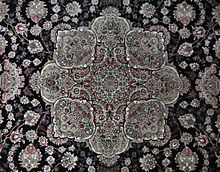
Rug design can be described by the way the ornaments are arranged within the pile. One basic design may dominate the entire field, or the surface may be covered by a pattern of repeating figures.
In areas with traditional, time-honoured local designs, such as the Persian nomad tribes, the weaver is able to work from memory, as the specific patterns are part of the family or tribal tradition. This is usually sufficient for less elaborate, mostly rectilinear designs. For more elaborate, especially curvilinear designs, the patterns are carefully drawn to scale in the proper colours on graph paper. The resulting design plan is termed a "cartoon". The weaver weaves a knot for each square on the scale paper, which allows for an accurate rendition of even the most complex designs. Designs have changed little through centuries of weaving. Today computers are used in the production of scale drawings for the weavers.[53]
The surface of the rug is arranged and organized in typical ways, which in all their variety are nevertheless recognizable as Persian: One single, basic design may cover the entire field ("all-over design"). When the end of the field is reached, patterns may be cut off intentionally, thus creating the impression that they continue beyond the borders of the rug. This feature is characteristic for Islamic design: In the Islamic tradition, depicting animals or humans isprohibitedeven in a profane context, as Islam does not distinguish between religious and profane life. Since the codification of theQuranbyUthman Ibn Affanin 651 AD/19 AH and theUmayyadAbd al-Malik ibn Marwanreforms,Islamic arthas focused on writing and ornament. The main fields of Persian rugs are frequently filled with redundant, interwoven ornaments, often in form of elaborate spirals and tendrils in a manner calledinfinite repeat.[54]
Design elements may also be arranged more elaborately. One typical oriental rug design uses amedallion,a symmetrical pattern occupying the center of the field. Parts of the medallion, or similar, corresponding designs, are repeated at the fourcornersof the field. The common Persian "Lechek Torūnj" (medaillon and corner) design was developed in Persia for book covers and ornamentalbook illuminationsin the fifteenth century. In the sixteenth century, it was integrated into carpet designs. More than one medallion may be used, and these may be arranged at intervals over the field in different sizes and shapes. The field of a rug may also be broken up into different rectangular, square, diamond or lozenge shaped compartments, which in turn can be arranged in rows, or diagonally.[34]
In contrast to Anatolian rugs, the Persian carpet medaillon represents the primary pattern, and the infinite repeat of the field appears subordinate, creating an impression of the medaillon "floating" on the field.[55]
In most Persian rugs, the field of the rug is surrounded by stripes, or borders. These may number from one up to over ten, but usually there is one widermain bordersurrounded by minor, orguardian borders.The main border is often filled with complex and elaborate rectilinear or curvilinear designs. The minor border stripes show simpler designs like meandering vines. The traditional Persian border arrangement was highly conserved through time, but can also be modified to the effect that the field encroaches on the main border. This feature is often seen in Kerman rugs from the late nineteenth century, and was likely taken over from FrenchAubussonorSavonnerieweaving designs.
The corner articulations are a particularly challenging part of rug design. The ornaments have to be woven in a way that the pattern continues without interruption around the corners between horizontal and vertical borders. This requires advance planning either by a skilled weaver who is able to plan the design from start, or by a designer who composes a cartoon before the weaving begins. If the ornaments articulate correctly around the corners, the corners are termed to be "resolved", or "reconciled". In village or nomadic rugs, which are usually woven without a detailed advance plan, the corners of the borders are often not resolved. The weaver then discontinues the pattern at a certain stage, e.g., when the lower horizontal border is finished, and starts anew with the vertical borders. The analysis of the corner resolution helps distinguishing rural village, or nomadic, from workshop rugs.
-
Basic design elements of an Oriental carpet
-
Book binding from Collected Works (Kulliyat), 10th century AH/AD 16th, Walters Art Museum
-
Serapi carpet, Heriz region, Northwest Persia, circa 1875, with predominantly rectilinear design
-
Corner articulations in Oriental rugs
Smaller and composite design elements[edit]
The field, or sections of it, can also be covered with smaller design elements. The overall impression may be homogeneous, although the design of the elements themselves can be highly complicated. Among the repeating figures, thebotehis used throughout the "carpet belt". Boteh can be depicted in curvilinear or rectilinear style. The most elaborate boteh are found in rugs woven aroundKerman.Rugs fromSeraband,Hamadan, and Fars sometimes show the boteh in an all-over pattern. Other design elements include ancient motifs like theTree of life,or floral and geometric elements like, e.g., stars or palmettes.
Single design elements can also be arranged in groups, forming a more complex pattern:[25][34]
- TheHeratipattern consists of a lozenge with floral figure at the corners surrounded by lancet-shaped leaves sometimes called "fish". Herati patterns are used throughout the "carpet belt"; typically, they are found in the fields ofBidjar rugs.
- TheMina Khanipattern is made up of flowers arranged in a rows, interlinked by diamond (often curved) or circular lines. frequently all over the field. The Mina Khani design is often seen onVaramin rugs.
- TheShah Abbasidesign is composed of a group of palmettes. Shah Abbasi motifs are frequently seen inAran va bidgol,Kashan,Isfahan,MashhadandNainrugs.
- TheBid Majnūn,or Weeping Willow design is in fact a combination of weeping willow, cypress, poplar and fruit trees in rectilinear form. Its origin was attributed to Kurdish tribes, as the earliest known examples are from the Bidjar area.
- TheHarshangor Crab design takes its name from its principal motive, which is a large oval motive suggesting a crab. The pattern is found all over the rug belt, but bear some resemblance to palmettes from the Safavid period, and the "claws" of the crab may be conventionalized arabesques in rectilinear style. This design was first used in theKhorasandistrict in Persia, and in origin ultimately derives from theIsfahan‘in and out’ palmette design.[56]
- TheGol Henaismall repeating pattern is named after the Henna plant, which it does not much resemble. The plant looks more like the Garden balsam, and in the Western literature is sometimes compared to the blossom of the Horse chestnut.
Common motifs in Persian carpets
-
Botehmotif
-
Bidjar rug withHeratipattern
-
Pictorial carpet with Tree of life, birds, plants, flowers and vase motifs
-
Safavid period carpet (detail):Shah Abbasimotif
-
Karaja carpet withBid Majnūn,or "weeping willow" design
-
Northwest Persia, 18th century carpet withHarshangor crab design
-
Bijar Rug withBid Majnūn,or "weeping willow" design
-
A carpet from Varamin with theMina Khanimotif
-
Pictorial carpet:Quran verses are woven into a Persian carpet
Classification[edit]
Persian carpets are best classified by the social context of their weavers. Carpets were produced simultaneously by nomadic tribes, in villages, town and court manufactures, for home use, local sale, or export.
Nomadic/tribal carpets[edit]
Nomadic, or tribal carpets are produced by different ethnic groups with distinct histories and traditions. As the nomadic tribes originally wove carpets mainly for their own use, their designs have maintained much of the tribal traditions. However, during the twentieth century, the nomadic lifestyle was changed to a more sedentary way either voluntarily, or by the forced settlement policy of the last Persian emperors of thePahlavi dynasty.By 1970, it was observed that traditional weaving had almost ceased among major nomadic tribes,[41][57]but in recent years, the tradition has been revived.[44]
Technical characteristics of Persian nomadic carpets
| Kurds | Bakhtiari & Luri | Chahar Mahal | Qashqai & Khamseh | Afshari | Beluch | |
|---|---|---|---|---|---|---|
| Knots | symmetric | symmetric | symmetric | symmetric and asymmetric, open to the left | symmetric and asymmetric, open to the right | mainly asymmetric open left, few open right or symmetric |
| Warps and wefts | Wool, sometimes cotton. Warps white or brown, wefts brown or red | Wool, goat hair, cotton. Warps brown or white, wefts brown or red. | Cotton, wefts sometimes blue | Wool, warps white (Q.) or white and brown (Kh.), wefts natural colours or red (Q.), or red and brown (Kh.) | Wool, warps white and brown, wefts orange red or pink | Warps white, wfts dark brown, later cotton |
| Selvages | overcast and reinforced | dark brown or goat hair, reinforced | reinforced, black wool | reinforced, two colours (Q.), overcast and reinforced, natural or dyed wool (Kh.) | reinforced with dyed wool | overcast in brown wool or goat hair |
| Ends | Kilim,2 cm (0.79 in) to very long | Kilim, 2–8 cm (0.79–3.15 in), natural colours or stripes | Kilim, 2–5 cm (0.79–1.97 in) | Kilim, 2–5 cm (0.79–1.97 in), interlaced or brocaded | Kilim, 2–15 cm (0.79–5.91 in), natural colours or dyed stripes | 2–25 cm (0.79–9.84 in), coloured stripes and brocaded |
| Predominant colours | yellow, natural or corrosive brown | dark blue, bright red, strong yellow | dark blue, bright red, strong yellow | bright, shining red, different hues of blue, scarcely yellow, green | red changing into yellow, salmon red | bright blue |
Kurds[edit]
TheKurdsare anethnic group,mostly inhabiting the area spanning adjacent parts of southeastern (Turkey), western (Iran), northern (Iraq), and northern (Syria).[58]The large population and the wide geographical distribution of the Kurds account for a varied production spanning a spectre from coarse and naïve nomadic weavings to the most elaborate town manufacture carpets, finely woven like Senneh, or heavy fabrics likeBijarcarpets.[59]Although Kurdish rugs represent a traditional part of Persian rug production, they merit separate consideration.
Senneh carpets[edit]

The city ofSanandij,formerly known as Senneh, is the capital ofIran's Kurdistan province.The rugs produced here are still known, also in the Iran of today, under their trade name "Senneh". They belong to the most finely woven Persian rugs, with knot counts up to 400 per square inch (6200/ dm2). The pile is closely clipped, and the foundation is cotton, also silk was used in antique carpets. Some fine carpets have silk warps dyed in different colours which create fringes in different colours known as "rainbow warps" in the rug trade. Mostly blue colours are used in the field, or a pale red. The predominant pattern used to be the Herati pattern, with a lozenge-shaped central medallion also filled with repeating Herati patterns on a different background colour. More realistic floral patterns are also seen, probably in rugs woven for export to Europe.[45]
Bijar carpets[edit]
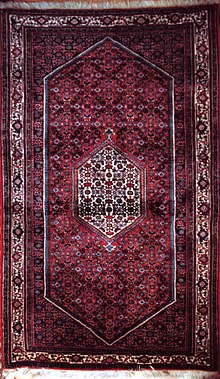
The town ofBijarlies around 80 kilometres (50 miles) northeast of Sanadij. Together, these two towns and their surrounding areas have been major centers of rug production since the eighteenth century. Carpets woven in Bijar and the surrounding villages show more varied designs than Senneh rugs, which has led to the distinction between "city" and "village" Bijar rugs. Often referred to as "The Iron Rug of Persia", the Bijar rug is distinguished by its highly packed pile, which is produced by a special technique known as "wet weaving", with the help of a special tool. Warps, weft and pile are constantly kept wet during the weaving process. When the finished carpet is allowed to dry, the wool expands, and the fabric becomes more compact. The fabric is further compacted by vigorous hammering on nail-like metal devices which are inserted between the warps during the weaving. Alternate warps are moderately to deeply depressed. The fabric is further compacted by using wefts of different thickness. Usually one of three wefts is considerably thicker than the others. The knots are symmetrical, at a density of 60 to over 200 per square inch (930–2100/ dm2), rarely even over 400 (6200/ dm2).
The colours of Bijar rugs are exquisite, with light and dark blues, and saturated to light, pale madder red. The designs are traditionally Persian, with predominant Herati, but also Mina Khani, Harshang, and simple medallion forms. Frequently the design is more rectilinear, but Bijar rugs are more easily identified by their peculiar, stiff and heavy weaving than by any design. Bijar rugs cannot be folded without risking to damage the foundation. A specific feature is also the lack of outlining, particularly of the smaller patterns. Full-size "sampler" carpets showing only examples of field and border designs rather than a fully developed carpet design are called "vagireh" by rug traders, and are frequently seen in the Bijar area. New Bijar carpets are still exported from the area, mostly with less elaborate Herati designs and dyed with good synthetic dyes.[45]
Kurdish village rugs[edit]
From a Western perspective, there is not much detailed information about Kurdish village rugs, probably because there is insufficient information to identify them, as they have never been specifically collected in the West. Usually, rugs can only be identified as "northwest Persian, probably Kurdish".[45]As is generally the case with village and nomadic rugs, the foundation of village rugs is more predominantly of wool. Kurdish sheep wool is of high quality, and takes dyes well. Thus, a rug with the distinct features of "village production", made of high-quality wool with particularly fine colours may be attributed to Kurdish production, but mostly these attributions remain educated guesswork. Extensive use of common rug patterns and designs poses further difficulty in assigning a specific regional or tribal provenience. A tendency of integrating regional traditions of the surrounding areas, like Anatolian or northwestern Persian designs was observed, which sometimes show distinct, unusual design variations leading to suggest a Kurdish production from within the adjacent areas. Also, northwestern Persian towns like Hamadan, Zenjan or Sauj Bulagh may have used "Kurdish" design features in the past, but modern production on display at the Grand Persian Exhibitions seems to focus on different designs.[45]
Qashqai[edit]
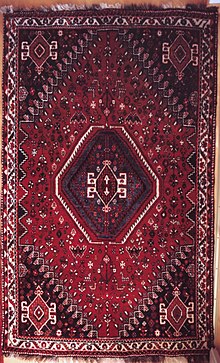


The early history of theQashqai peopleremains obscure. They speak a Turkic dialect similar to that of Azerbaijan, and may have migrated to the Fars province from the north during the thirteenth century, possibly driven by the Mongol invasion.Karim KhanZand appointed the chief of the Chahilu clan as the first Il-Khan of the Qashqai.[25]The most important subtribes are the Qashguli, Shishbuluki, Darashuri, Farsimadan, and Amaleh. The Gallanzan, Rahimi, and Ikdir produce rugs of intermediate quality. The rugs woven by the Safi Khani and Bulli subtribes are considered among the highest quality rugs.[57]The rugs are all wool, usually with ivory warps, which distinguishes Qashqai from Khamseh rugs. Qashqai rugs use asymmetric knots, while Gabbeh rugs woven by Qashqai more often use symmetric knots. Alternate warps are deeply depressed. Wefts are in natural colours or dyed red. The selvedges are overcast in wool of different colours, creating a "barber pole" pattern, and are sometimes adorned with woolen tassels. Both ends of the rug have narrow, striped flat-woven kilims. Workshops were established in the nineteenth century already around the town ofFiruzabad.Rugs with repeating boteh and the Herati pattern, medallion, as well as prayer rug designs resembling the millefleurs patterns of Indian rugs were woven in these manufactures. The Herati design may sometimes appear to be disjointed and fragmented. The Qashqai are also known for their flatweaves, and for their production of smaller, pile-woven saddle bags, flat-woven larger bags (mafrash), and theirGabbehrugs.
TheShishbuluki(lit.:"six districts" ) rugs are distinguished by small, central, lozenge-shaped medallions surrounded by small figures aligned in concentric lozenges radiating from the center. The field is most often red, details are often woven in yellow or ivory.Darashurirugs are similar to those of the Shishbuluki, but not so finely woven.[60]
As the truly nomadic way of life has virtually come to an end during the twentieth century, most Qashqai rugs are now woven in villages, using vertical looms, cotton warps, or even an all-cotton foundation. They use a variety of designs associated with the Qashqai tradition, but it is rarely possible to attribute a specific rug to a specific tribal tradition. Many patterns, including the "Qashqai medallion" previously thought to represent genuine nomadic design traditions, have been shown to be of town manufacture origin, and were integrated into the rural village traditions by a process of stylization.[34]
The revival of natural dyeing has had a major impact on Qashqai rug production. Initiated inShirazduring the 1990s by master dyers as Abbas Sayahi,[44]particularlyGabbehrugs raised much interest when they were first presented at the Great Persian Exhibition in 1992. Initially woven for home use and local trade, coarsely knotted with symmetric knots, the colours initially seen were mostly natural shades of wool. With the revival of natural colours, Gabbeh fromFars provincesoon were produced in a full range of colours. They met the Western demand for primitive, naïve folk art as opposed to elaborate commercialized designs, and gained high popularity. In the commercial production of today, the Gabbeh rug patterns remain simple, but tend to show more modern types of design.[45]
Khamseh federation[edit]

TheKhamseh(lit.:"five tribes" ) federation was established by the PersianQajargovernment in the nineteenth century, to rival the dominant Qashqai power. Five tribal groups of Arab, Persian and Turkic origin were combined, including the Arab tribe, theBasseri,Baharlu, Ainalu, and Nafar tribes.[57]It is difficult to attribute a specific rug to the Khamseh production, and the label "Khamseh" is often used as a term of convenience. Dark woolen warps and borders are associated withArabKhamseh rugs, warps are rarely depressed, the colour scheme is more subdued. Specifically, a stylized bird ("murgh") pattern is often seen on rugs attributed to the confederation, arranged around a succession of small, lozenge shaped medallions.Basserirugs are asymmetrically knotted, brighter in colours, with more open space and smaller ornaments and figure with Orange as the specific color.[45]TheBaharluare a Turkic-speaking tribe settled aroundDarab,and few carpets are known from this more agricultural region.
Luri[edit]
TheLurslive mainly in western and south-western Iran. They are of Indo-European origin. Theirdialectis closely related to theBakhtiari dialectand to the dialect of the southernKurds.Their rugs have been marketed inShiraz.The rugs have a dark wool foundation, with two wefts after each row of knots. Knots are symmetrical or asymmetrical. Small compartment designs of repeating stars are often seen, or lozenge-shaped medallions with anchor-like hooks on both ends.[57]
Afshari[edit]
TheAfshar peopleare a semi-nomadic group of Turkic origin, principally located in the mountainous areas surrounding the modern city ofKermanin southeastern Iran. They produce mainly rugs in runner formats, and bags and other household items with rectilinear or curvilinear designs, showing both central medallions and allover patterns. Colours are bright and pale red. The flat-woven ends often show multiple narrow stripes.[50]
balochi[edit]
TheBaloch peoplelive in eastern Iran. They weave small-format rugs and a variety of bags with dark red and blue colours, often combined with dark brown and white. Camel hair is also used.[50]
Village carpets[edit]
Carpets produced in villages are usually brought to a regional market center, and carry the name of the market center as a label. Sometimes, as in the case of the "Serapi" rug, the name of the village serves as a label for a special quality. Village carpets can be identified by their less elaborate, more highly stylized designs.[50]
Criteria suggesting village production include:[61]
- A rug of so-called scatter-size (dozar) that has been woven in a settled environment;
- woven without a cartoon;
- woven without reconciled corners;
- woven with possible idiosyncrasies of construction and pattern elements.
Village rugs are more apt to have warps of wool rather than of cotton. Their designs are not as elaborate and ornate than the curvilinear patterns of city rugs. They are more likely to display abrash and conspicuous mistakes in detail. On simple vertical looms, the correct tension of the warps is difficult to maintain during the entire weaving process. So, village rugs tend to vary in width from end to end, have irregular sides, and may not lay entirely flat. In contrast to manufactory rugs, there is considerable variety in treating the selvedges and fringes. Village rugs are less likely to present depressed warps, as compared to manufactory rugs. They tend to make less use of flat woven kilim ends to finish off the ends of the rug, as compared to tribal rugs. The variation in treatment of fringes and ends, and the way the selvedges are treated, provide clues as to place of origin.[61]
Northwestern Iran[edit]
Tabrizis the market center for the Iranian Northwest. Carpets woven in this region mainly use the symmetric knot.Herizis a local center of production for mainly room-size carpets. Warps and weft are of cotton, the weaving is rather coarse, with high-quality wool. Prominent central medaillons are frequently seen with rectilinear outlines highlighted in white. The ornaments of the field are in bold, rectilinear style, sometimes in an allover design. Higher quality Heriz carpets are known as Serapi. The village ofSarabproduces runners and galleries with broad main borders either of camel hair or wool dyed in the colour of camel hair. Large, interconnected medaillons fill the field. Mostly rectilinear, geometric and floral patterns are dyed in pink red and blue.Bakshaish carpetswith a shield-shaped large medaillon, less elaborate rectilinear patterns in salmon red and blue are labeled after the village ofBakhshayesh.Karadja produces runners with specific square and octagonal medaillons in succession.[50]
Western Iran[edit]
Major production centers in the West areHamadan,Sarukwith its neighbouring town ofArak,Minudashtalso known under the trade nameLilihanand Serabend, Maslaghan,Malayerand Feraghan.
- Carpets fromMaslaghanare usually small (120 × 180 cm), the warps are made of cotton, the wefts of wool or cotton. The large medaillon shows a so-called "lobedGöl",the colours of which are in sharp contrast to the field, with small borders. Malayer, Sarouk and Feraghan are located closely to each other. They use cotton for the foundation.[50]
- Malayercarpets are distinguished by their single-weft and the use of the symmetrical knot. Allover and medaillon patterns are common, the boteh motif is frequently used.[50]
- The originalSaroukdesign was distinguished by a round-star medaillon with surrounding pendants. The traditional design of the Sarouk rug was modified by the weavers towards an allover design of detached floral motives, the carpets were then chemically washed to remove the unwanted colours, and the pile was painted over again with more desirable colours.[25]Feraghancarpets are less finely woven than Sarouk. Often the Herati pattern is seen all over. Medaillons, if they occur, show more geometrical designs. A corroding green dye is typical for Feraghan carpets.[50]
Southern Iran[edit]
Since the mid-twentieth century, commercial production started in the villages ofAbadehand Yalameh.Abadeh rugsadopted traditionalQashqaidesigns, but used cotton for warps and wefts, the latter often dyed in blue.Yalamehcarpets more resembleKhamsehdesigns with hooked medaillons arranged in the field. Warps and wefts were often in white.[50]
Eastern Iran[edit]
The village of Doroksh is known for its carpet production in Eastern Persia. They are characterized by their use of orange dyes, the boteh motif is often seen. Usually, there is only one border. The knots are asymmetric.[50]
Town carpets[edit]

Tabrizin the West,KermanRavarin the South, andMashhadin the Northeast of Iran, together with the central Iranian towns Such as:Aran va bidgol,Kashan,Ravar,Isfahan,NainandQomare the main centers of town manufacture.[50]
- Aran va bidgolhas the best and most beautiful carpets and rugs in Iran. Its beauty, charm and softness have made this city the largest center of machine carpet production in Iran and the second largest manufacturer of machine carpet in the world.
- Tabrizhas been a center of carpet production for centuries. Many designs are reproduced by Tabrizi weavers, with wool or silk in the pile, and wool, cotton or silk in the foundation.
- Kermanis known for finely knotted, elegant carpets with prominent cochineal red, ivory and golden yellow colours. Their medaillons are elegantly designed, and elaborate versions of the boteh design are often seen in the field.
- Mashhadcarpets are of average quality. Cochineal red is often used. Emogli (Amoghli) carpets are made of silk, and represent the finest carpets manufactured in Mashhad. They show dense arabesque patterns on red ground.
- Kashanis the oldest carpet-producing city in Central Iran. Famous for its production of silk carpets, carpet weaving was revived in the late 19th century. The earliest carpets woven in Kashan at the turn of the nineteenth century show some imbalances in their designs, which was overcome, and carpets were produced mainly with a red or ivory field and elaborate ogival central medallions.
- Isfahan,Nain,andQomrevived or started carpet manufacture by the mid-twentieth century. All-silk, or silk pile on cotton foundation carpets are produced with asymmetrical knots. Their design is often inspired bySafaviddesigns. Carpets from Qom and Nain often have richly decorated medaillons, and tender light blue and ivory colours. Isfahan carpets use more dark red and blue colours.
Proveniences[edit]
Commercial aspects[edit]

Iran exported $517 million worth of hand-woven carpets in 2002. Iran's carpet exports amounted to US$635 million in 2004[needs update],according to the figures from the state-owned Iran Carpet Company. In October 2006, National Iranian Carpet Center revealed that hand-woven carpets have ranked first in country's non-oil exports and hold the third position among overall exports. Nearly five million workers are engaged in the Iranian carpet industry, making it one of the biggest enterprises in the country[citation needed].
The absence of modernR&Dis causing rapid decline in the size as well as market value of this art.[62]
In 2008,Iran’s exports of hand-woven carpets was $420 million or 30% of the world's market.[63][64]Iran exports carpets to more than 100 countries, as hand-woven rugs are one of its main non-oil export items. The United States is the single largest importer of Persian hand woven carpets. In 2011, President Obama signed into law an act that greatly enhanced restrictions on Iranian-origin imports, causing the imports of Iranian carpets to be halted. After certain sanctions were lifted onimplementation dayon January 16, 2016, Iran's exports of carpets in the first quarter amounted to $60 million.[65]In 2017, Iran exported $24.3 million worth of hand-woven carpets but was far from the top producer Turkey, which exported $1.77 billion worth of hand-woven carpets in the same year.[66]
Trivia[edit]
- The idiom "Persian flaw", meaning a deliberate mistake, is said to originate from the notion that Persian weavers would intentionally leave imperfections in each rug in the belief that only God's creations are perfect, and to weave a perfect rug would be an insult to God.[67]
- The most famous Persian carpet is theArdabil Carpet,in theVictoria and Albert Museumin London, which in fact is now a combination of two original carpets, with another piece from the second in Los Angeles.[68]This has been the subject of endless copies ranging in size from small to full scale. There is an 'Ardabil' at10 Downing Street,and evenHitlerhad an 'Ardabil' in his office inBerlin.[68][69]
- The most expensive carpet in the world is a 17th-century Persian vase style carpet, afshar collection which was sold in June 2013 in an London auction for $33.8m.[70]
- The "Carpet of Wonder" in theSultan Qaboos Grand MosqueinMuscat,in theSultanate of Oman,measures 4,343 square metres (46,750 square feet). Its construction required four years of labour by 600 workers, resulting in 12 million man hours of work.[71]
- Iran is also the maker of the largest handmade carpet in history, measuring 5,624.9 square metres (60,545.9 square feet).[72][73][74]
See also[edit]
| Part ofa serieson the |
| Culture of Iran |
|---|
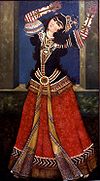 |
|
|
Types[edit]
- Dilmaghani
- Gabbeh
- Gelim(AlsoKilimorKelim)
- Heriz rug
- Kashan rug
- Tabriz rug
Related carpet[edit]
Popular culture[edit]
- Baharestan Carpet
- Carpet Museum of Iran
- Flying carpet
- Nazmiyal collection
- The Poot(Persian carpet documentary)
- War rugs
- The Phoenix and the Carpet
References[edit]
- ^abSavory, R.,Carpets,(Encyclopaedia Iranica); accessed January 30, 2007.
- ^"UNESCO Representative List of the Intangible Cultural Heritage of Humanity".Retrieved9 August2015.
- ^"UNESCO Representative List of the Intangible Cultural Heritage of Humanity".Retrieved9 August2015.
- ^Pinner, R. (1983). "The First Carpets".Hali.5(2): 11.
- ^Haider, R.,Carpet that Captive
- ^Nouri-Zadeh, Sh.,Turkish Carpet; The Beautiful Picture of Art in History,
- ^Rubinson, Karen S.,"Animal Style" Art & the Image of the Horse and Rider
- ^S.I. Rudenko,Kul'tura naseleniia Gornogo Altaia v skifskoe vremia(Moscow and Leningrad, 1953)
- ^Rudenko, Sergei I., Frozen Tombs of Siberia, The Pazyryk Burials of Iron-Age Horseman (University of California Press, Berkeley and Los Angeles, California, 1970)
- ^Lerner J.,Some So-called Achaemenid Objects from Pazyryk,Source: Notes in the History of Art, vol. 10, no. 4:8–15 (1991).
- ^Harald Böhmer and Jon Thompson,The Pazyryk Carpet: A Technical Discussion,Source: Notes in the History of Art, vol. 10, no. 4:30–36 (1991).
- ^Spuhler, Friedrich (1987).Die Orientteppiche im Museum für Islamische Kunst Berlin(1st ed.). Munich: Klinkhardt and Biermann.ISBN3-7814-0270-3.
- ^Pfister, R.; Bellinger, L. (1945).The Excavations at Dura-Europos; IV Vol. 2 The Textiles(1st ed.). New Haven: Yale University Press.
- ^Fujii, Hideo; Sakamoto, Kazuko (1993). Eiland, M.L. (ed.). "The marked characteristics of carpets unearthed from the At-Tar caves, Iraq".Oriental Carpet and Textile Studies.IV.Berkeley: 35–40.
- ^Κύρου Ανάβασις/Ζ
- ^International Congress of Byzantine StudiesProceedings of the 21st International Congress of Byzantine Studies, London, 21–26 August 2006, Volumes 1–3pp 29. Ashgate Pub Co, 30 sep. 2006ISBN075465740X
- ^Ekthiar, MD; Soucek, PP; Canby, SR; Haidar, NN (2012).Masterpieces from the Department of Islamic Art in the Metropolitan Museum of Art(2nd ed.). New York: Yale University Press. pp. 20–24.ISBN978-1-58839-434-7.
- ^Brüggemann, Werner (2007).Der Orientteppich/The Oriental Carpet(1st ed.). Wiesbaden, Germany: Dr Ludwig Reichert Verlag. pp. 87–176.ISBN978-3-89500-563-3.
- ^N. (no author), N. (1993).Splendeur des Sassanides: L'empire Perse entre Rome et la Chine (224–642) / the Splendor of the Sassanians: the Persian Empire between Rome and China (224–642).Brussels: Credit Communal.
{{cite book}}:|last1=has generic name (help) - ^abvon Bode, Wilhelm; Kühnel, Ernst (1985) [1970].Vorderasiatische Knüpfteppiche[Antique Rugs from the Near East] (in German). Translated by C. G. Ellis (5th ed.). Munich: Klinkhardt and Biermann. p. 78.ISBN3-7814-0247-9.
- ^at-Tabarī, Abū Dschaʿfar Muhammad ibn Dscharīr (2007). Yarshater, Ehsan (ed.).History of at-Tabari Vol 14.Albany, NY: State University of New York Press.ISBN978-0-7914-7249-1.
- ^Spuhler, Friedrich (2012).Carpets from Islamic Lands(1st ed.). London: Thames & Hudson. pp. 14–19.ISBN978-0-500-97043-0.
- ^"Kuwait Dar al-Athar al-Islamiyyah rugs and textiles collection".Dar al-Athar al-Islamiyyah.Archived fromthe originalon 25 July 2015.Retrieved25 July2015.
- ^Spuhler, Friedrich (2013).Pre-Islamic carpets and textiles from eastern lands(1st ed.). Farnborough: Thames & Hudson Ltd.ISBN9780500970546.
- ^abcdefghijklmnopqrsEdwards, A. Cecil (1975).The Persian carpet: a survey of the carpet-weaving industry of Persia(Reprinted 1952 ed.). London: Duckworth.ISBN978-0715602560.
- ^Erdmann, Kurt (1938). "Kairener Teppiche Teil I. Europäische und Islamische Quellen vom 15.-18. Jahrhundert" [Cairene Carpets Part I. European and Islamic Sources from the 15.-18. Century].Ars Islamica.5(2). Freer Gallery of Art, The Smithsonian Institution and Department of the History of Art, University of Michigan: 181.JSTOR4520928.
- ^Martin, F.R. (1908).A History of Oriental Carpets before 1800(1 ed.). Vienna: Printed for the author in the I. and R. State and Court Print.
- ^Riefstahl, Rudolf Meyer(December 1931). "Primitive Rugs of the" Konya "type in the Mosque of Beyshehir".The Art Bulletin.13(4): 177–220.
- ^Lamm, C.J. (1985).Carpet fragments: The Marby rug and some fragments of carpets found in Egypt (Nationalmuseums skriftserie)(1937 reprint ed.). Swedish National Museum.ISBN978-9171002914.
- ^"Worldcat".Retrieved8 August2015.
- ^de Clavijo, Ruy Gonzáles (2009). Le Strange, Guy (ed.).Embassy to Tamerlane, 1403–1406.Kilkerran: Hardinge Simpole.ISBN978-1843821984.
- ^Savory, Roger (2007).Iran under the Safavids(1. publ. ed.). Cambridge [u.a.]: Cambridge Univ. Press.ISBN978-0521042512.
- ^Briggs, Amy (1940). "Timurid Carpets; I. Geometric carpets".Ars Islamica.7:20–54.
- ^abcdFord, P.R.J. (1981).Oriental Carpet Design(1st ed.). London: Thames & Hudson Ltd.ISBN9780500276648.
- ^Erdmann, Kurt (1965).Der Orientalische Knüpfteppich. tr. C. G. Ellis as Oriental Carpets: An Essay on Their History, New York, 1960(3rd ed.). Tübingen: Verlag Ernst Wasmuth. pp. 30–32.
- ^abcErdmann, Kurt (1970). Erdmann, Hanna; Beattie (transl.), May H. (eds.).Seven hundred years of Oriental carpets.Berkeley: University of California Press.ISBN978-0520018167.
- ^Beattie, May H. (1976).Carpets of Central Persia: with special references to rugs of Kirman.[S.l.]: World of Islam Festival Pub. Co. pp. 19–28.ISBN0905035178.
- ^abFerrier, R.W. (1989).The arts of Persia.New Haven: Yale Univ. Press. pp. 124–125.ISBN0300039875.
- ^Axworthy, Michael (2008).The sword of Persia: Nader Shah, from tribal warrior to conquering tyrant(1st ed.). London: I. B. Tauris. pp. 17–56.ISBN978-1845119829.
- ^Hillmann, Michael Craig (1989). "A cultural-aesthetic analysis of a modern Persian carpet".Oriental Rug Review.9(6): 29–31.
- ^abOpie, James (1992).Tribal rugs – Nomadic and Village Weavings from the Near East and Central Asia(1st ed.). Laurence King Publishing.ISBN1-85669-025-3.
- ^Eiland, Murray (1998)."Mixed Messages and Carpet Diplomacy: Opportunities for Detente with Iran".Middle East Policy.6(2): 130–138.doi:10.1111/j.1475-4967.1998.tb00313.x– via academia.edu.
- ^Eilland, Murray L. III (1994). "Persian design: A step forward".The Decorative Rug.7(9): 40–46.
- ^abcdOpie, James (1992). "Vegetal Dyes: Iran restores an ancient tradition".Oriental Rug Review.III(10): 26–29.
- ^abcdefghijklEilland, Murray L. Jr.; Eilland, Murray III (1998).Oriental Rugs – A Complete Guide(revised ed.). London: Callmann & King Ltd.
- ^Kadolph, Sara J., ed.:Textiles,10th edition, Pearson/Prentice-Hall, 2007,ISBN0-13-118769-4,p. 197
- ^Boehmer, Harald (1983). "The Revival of Natural Dyeing in Two Traditional Weaving Areas of Anatolia".Oriental Rug Review.III(9): 2.
- ^Atlihan, Serife (1993). "Traditional Weaving in One Village of Settled Nomads in Northwest Anatolia".Oriental Carpet and Textile Studies.IV.
- ^Eilland, Emmett (2003).Oriental Rugs Today(2 ed.). Berkeley Hills Books, Albany, CA. pp. 50–59.ISBN1-893163-46-6.
- ^abcdefghijkO'Bannon, George (1995).Oriental rugs: the collector's guide to selecting, identifying, and enjoying new and vintage oriental rugs(1st ed.). Pennsylvania, Pa.: Courage Press.ISBN9781561385287.
- ^abcde"Types of carpets loom and knowledge of its components".Farahan Carpet.18 April 2021.
- ^"Tools: Loom".caroun.
- ^Oriental Rugs: A Complete Guide, byMurray L. Eiland Jr.& Murray Eiland III, London 2008, page 66
- ^Erdmann, Kurt (1943). "Zum Orientteppich".Asienberichte.5(19). Vienna: 20.
- ^Erdmann, Kurt (1965).Der Orientalische Knüpfteppich. tr. C. G. Ellis as Oriental Carpets: An Essay on Their History, New York, 1960(3rd ed.). Tübingen: Verlag Ernst Wasmuth. pp. 47–51.
- ^"Oriental rugs: the meanings behind the designs" by Louise Broadhurst, Head ofChristie'sOriental Rugs & Carpets department
- ^abcdOpie, James (1981).Tribal Rugs of Southern Persia(1st ed.). Portland, Oregon: James Opie Oriental Rugs Inc.
- ^Bengio, Ofra (2014).Kurdish awakening: Nation building in a fragmented homeland.[S.l.]: Univ of Texas Press.ISBN978-0292758131.
- ^Eagleton, William (1988).An introduction to Kurdish rugs and other weavings(1st American ed.). New York: Interlink Books.ISBN978-0940793170.
- ^Parham, Cyrus (1996).Masterpieces of Fars Rugs.Tehran: Soroush Press.
- ^abWilber, Donald N. (1989). "An introduction to Persian village rugs".Oriental Rug Review.9(6): 6–10.
- ^BBCPersian
- ^Iran-dailyArchived2008-12-09 at theWayback Machine
- ^FT
- ^Tajvidi K. (5 June 2014)."Persian Rugs & The Silent War On Decoration".Rug Academy. Archived fromthe originalon 6 April 2017.Retrieved5 April2017.
- ^"Which countries export Hand-Woven Rugs? (2017)".Observatory of Economic Complexity.Retrieved17 March2019.
- ^"Deliberate mistakes in handmade Persian rugs and carpets".orientalrugexperts.
- ^abHillyer, L.; Pretzel, B."The Ardabil Carpet – a new perspective".Conservation Journal(49). V&A Museum.Retrieved29 January2007.
- ^Wearden, J. (1995). "The Surprising Geometry of the Ardabil Carpet".Abstracts from the Ars Textrina Conference.Leeds.
- ^"Persian rug sold at auction for record $33.8m".BBC News.6 June 2013.
- ^"Rug 990".Persian Carpet Guide.
- ^"Iran-picture".National Geographic News.7 August 2007. Archived fromthe originalon 13 December 2007.
- ^"Payvand".Archived fromthe originalon 4 June 2011.Retrieved4 March2010.
- ^News.bbc.co.uk
Further reading[edit]
- Jenny Housego:Tribal Rugs: An Introduction to the Weaving of the Tribes of Iran,Scorpion Publications, London 1978ISBN978-0-905906-05-8
- Ulrich Schurmann:Oriental Carpets,Octopus Books Limited, London 1979ISBN0-7064-1017-3
- Ian Bennett:Oriental Rugs, Volume One: Caucasian,Oriental Textile Press Ltd, England, 1981ISBN978-0-902028-58-6
- Jan David Winitz:The Guide to Purchasing an Oriental Rug,The Breema Rug Study Society & Dennis Anderson Photo-Publishing, Oakland, 1984ISBN0-930021-002
- Andrew Middleton:Rugs & Carpets: Techniques, Traditions & Designs,Mitchell Beazley, London 1996ISBN1-85732-634-2
- Ulrich Schurmann:Caucasian Rugs,Washington International Associates, Accokeek, Maryland, 1974ISBN0-915036-00-2
- James D. Burns:Visions of Nature: The Antique Weavings of Persia,Umbrage Editions, Iceland, 2010ISBN978-1-884167-23-2
- Peter F Stone:Oriental Rugs: An Illustrated Lexicon of Motifs, Materials, and Origins,Tuttle Publishing 2013ISBN978-0804843737
External links[edit]
- Videos
- Persian Rug Lecture by Dr. Khosrow Sobhi– parstimes

